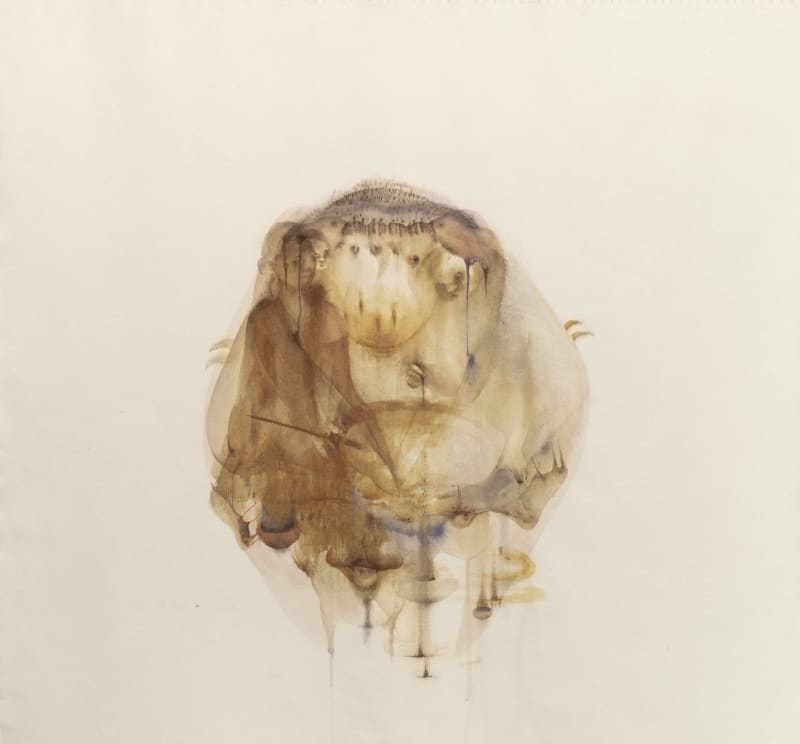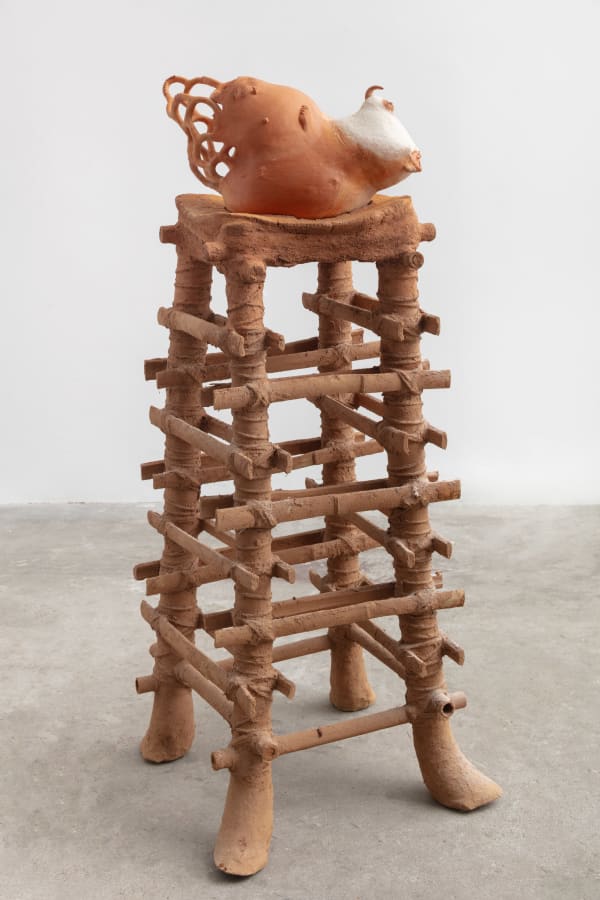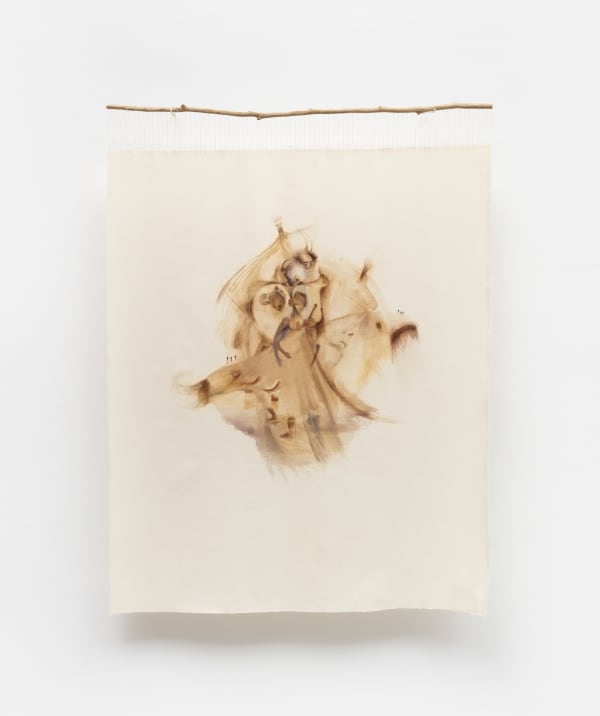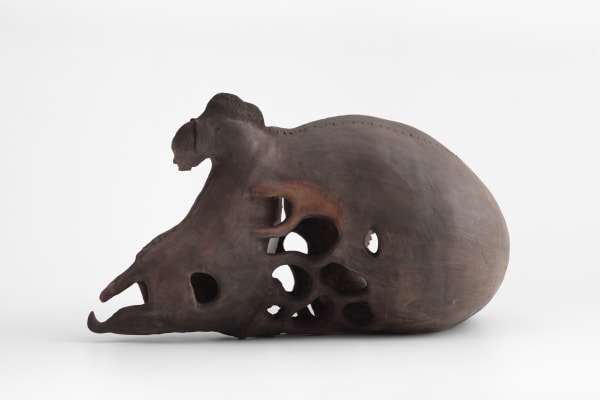grains of water, drops of earth Josi
Mendes Wood DM New York
Josi’s process unfolds in the movement of gestures, with handmade creations that make their presence felt as extensions of hands. Grains of earth come together and disperse, sticking to wherever they land. These grains pass through sieves and mortars. They decant, patiently passing through time. They are placed in a pan and swirl – until everything is there – for those who know how to see it. Within the earth’s hues, one senses the unfolding of life, everything happens, grounding, thickening until reaching a nearly direct contact with life itself. Stubborn kneading, watering, raising, smoothing, shining. Art, bordering on life, is a path that moves with the earth. It springs from temporalities and vibrations of the world, from before the world was what we know of it. The element of art is, then, a gesture with the earth. Touching life – living beings in clay, the traces of everything that is kept in it. Sensing temporalities, including geological ones, respecting the rhythms of the earth, engaging with them through materials. Acknowledging thresholds crossed by those who came before. These are experiences intertwined with Josi’s artistic gestures.
The weaving of Josi’s works comes from the strength of her hands, maneuvering and deviating from well-known canons within art that have become comfortable aesthetic reference points. In Josi’s process, a poetic fold seems to reveal itself: A body of work is born with a body of matter. Josi establishes places for the body to imbue itself with its own being and the soil through a shared and synchronous genesis. A collective and ancestral self and earth where confluences germinate, “a force that yields, that increases, that expands,” where “we become ourselves and another version of ourselves” as the quilombola intellectual and political activist Nêgo Bispo tells us. Creating, for Josi, is a “movement” in resonance, in confluence with the earth and the places of origin where she sources her materials, with what sprouts in/from those places, in a practice that seems to intensify outside language and breaks free from the tired grammars of contemporary art, which pretend to be universal.
Josi’s artistic journey began with sketches in notebooks on bus rides, embracing the belief that art is not a privilege. Her experiences in Itamarandiba, Carbonita, and Caeté shaped her life as a teacher. The wisdom from washing clothes and toiling in fields led to a Fine Arts degree at the Guignard School (UEMG). From the dirt floors of Tabatinga to the floor of the kitchen/studio, these places do not separate into borders but gather together because they are, at the same time, memory and an agglomeration of temporalities. From them, Josi creates. Through overlapping moments, places, and narratives, she identified inks and dyes while boiling beans in water, fruit stains were suddenly pigmenting surfaces, and muddy water formed earth and ground tones.
With these materials and gestures, Josi’s painting process emerges. She meticulously waits for the events that these pigments create. On the canvas, they reveal themselves in spreads, veils, concentrations, dissolutions, disappearances, transparencies, glazes, empty spaces, and color changes. There is no prior drawing, “no previous risk,” as she explains, because there is no way to stop or control what is not anticipated. Josi says she seeks a “curvature of color,” but the temporality of each pigment is an experience that distinguishes itself on paper and fabric while she paints and, therefore, the pigments interact in different ways, constantly responding to humidity, temperature, according to the composition of organic paints. There are no lines. Lines separate. The stains that she returns to in her work are tributaries on the canvas, they overlap, move, and occupy spaces. They create another temporality, another color, resurfacing in other images.
Josi approached clay because she understands it as soil that “walked from a rock, met the wind, the rain, and other beings, and then went to sediment, carrying along all that memory.” In her hands clay is handled like “treasure.” Dealing with clay is conversing with the tradition of making utensils present in daily life and with the ancestral ties and memories of the time when stepping on the ground was having that ground always present in life. Exile is the opposite: It is not having a place to step; it is relearning to walk, and, therefore, almost undoing oneself from the longing for people who once inhabited the land and were lost.
In Josi’s ceramics, there are faces, human figures, and contiguous bodies. Tool and body are unified as one, and, from there, figuration is a shelter that materializes the desire to populate life with the presence to recount other fables than ones about exile. In these sculptures, togetherness, community building, and fictional tales narrate a place that the body didn’t have the right to because emptiness and dispersion commanded the flow of life. “It’s where I come together completely,” says the artist. And again, working with clay, Josi draws on the knowledge and imagination she brings from the Jequitinhonha Valley – from people gathering together, from conversations, from the daily chores, from fruit drying in the sun. Touching this life in clay means gathering presences, reversing erasures, and enunciating ancestral knowledge.
grains of water, drops of earth is the title of Josi’s first international solo exhibition. The show brings together works created by touching, dragging, and mishmashing various temporalities, materials, people, presences, and stories. The works remind us that art “is a conversation of souls because it goes from the individual to the communal as it is shared” – once again, Nêgo Bispo tells us about the difference between exchange and sharing. And so Josi’s works invite us to practice other ways of seeing and making sense of life. Her creations are here to affirm the presence of people who have been expropriated from their gestures, separated from their environment (what modern civilization calls nature), who were tasked with overcoming (as a challenge, fate, and obligation) the oppressions of being alienated and placeless. The presence of people who resist the wars of colonialist denominations, creating relationships with every being and with the earth, which is the “original yearning.” As well as the presence of grains and drops, immense particles in this melting pot of life that we call the world.
– Galciani Neves
Josi (b. 1983, Itamarandiba, Brazil) lives and works in Belo Horizonte.
Josi’s works have been featured in the following solo exhibitions: arrastar chãos, juntar imbigos, Mendes Wood DM, São Paulo, Brazil (2024) and Quarar reverso, Piccola Galeria Casa Fiat de Cultura, Belo Horizonte, Brazil (2022). She has participated in the following group exhibitions: Imagens que não se conformam, Memorial Minas Vale, Belo Horizonte, Brazil (2023); Linhas Tortas, Mendes Wood DM, São Paulo, Brazil (2023); Ensaios para o Museu das Origens, Instituto Tomie Ohtake, São Paulo, Brazil (2023); O corpo invisível da memória, Museu da Inconfidência de Ouro Preto, Ouro Preto, Brazil (2023); Six Artists, Mendes Wood DM, New York, NY, USA (2023); Emoção de lidar, Quadra Galeria, São Paulo, Brazil (2023); Premiados Pipa 2022, Paço Imperial, Rio de Janeiro, Brazil (2022); 8 Prêmio Artes Tomie Ohtake, Instituto Tomie Othake, São Paulo, Brazil (2022); Ainda que tardia, Festival Internacional de Artes de Tiradentes, Museu Casa Padre Toledo, Tiradentes, Brazil (2022); Abre Alas 17, A Gentil Carioca Gallery, Rio de Janeiro, Brazil (2022); Algumas Histórias sobre nós, Danielian Gallery, Rio de Janeiro, Brazil (2022); VEZA 02, plataforma SOUTH SOUTH, Rio de Janeiro, Brazil (2022); and Entre o isolamento e o contato, Escola Guignard UEMG, Minas Gerais, Brazil (2020).
-
 Josi, unaúla, da série: isca de chão | unaúla, from the series: floor bait, 2024
Josi, unaúla, da série: isca de chão | unaúla, from the series: floor bait, 2024 -
 Josi, da série grão de água, gota de terra | from the series grains of water, drops of earth, 2024
Josi, da série grão de água, gota de terra | from the series grains of water, drops of earth, 2024 -
 Josi, aumbi, da série: rastapé | aumbi, from the series: rastapé, 2024
Josi, aumbi, da série: rastapé | aumbi, from the series: rastapé, 2024 -
 Josi, da série: chão de molho e imbigos | from the series: soaked floor and bellybuttons, 2024
Josi, da série: chão de molho e imbigos | from the series: soaked floor and bellybuttons, 2024 -
 Josi, da série: chão de molho e imbigos | from the series: soaked floor and bellybuttons, 2024
Josi, da série: chão de molho e imbigos | from the series: soaked floor and bellybuttons, 2024 -
 Josi, Igbin, 2024
Josi, Igbin, 2024 -
 Josi, da série: chão de molho e imbigos | from the series: soaked floor and bellybuttons, 2024
Josi, da série: chão de molho e imbigos | from the series: soaked floor and bellybuttons, 2024 -
 Josi, da série: chão de molho e imbigos | from the series: soaked floor and bellybuttons, 2024
Josi, da série: chão de molho e imbigos | from the series: soaked floor and bellybuttons, 2024 -
 Josi, urutuau,da série: isca de chão | urutuau, from the series: floor bait, 2024
Josi, urutuau,da série: isca de chão | urutuau, from the series: floor bait, 2024 -
 Josi, da série: chão de molho e imbigos | from the series: soaked floor and bellybuttons, 2024
Josi, da série: chão de molho e imbigos | from the series: soaked floor and bellybuttons, 2024 -
 Josi, indacas, 2024
Josi, indacas, 2024 -
 Josi, Abrigo da aroeira, da série: abrigos | Brazilian peppertree shelter, from the series: shelters, 2024
Josi, Abrigo da aroeira, da série: abrigos | Brazilian peppertree shelter, from the series: shelters, 2024














